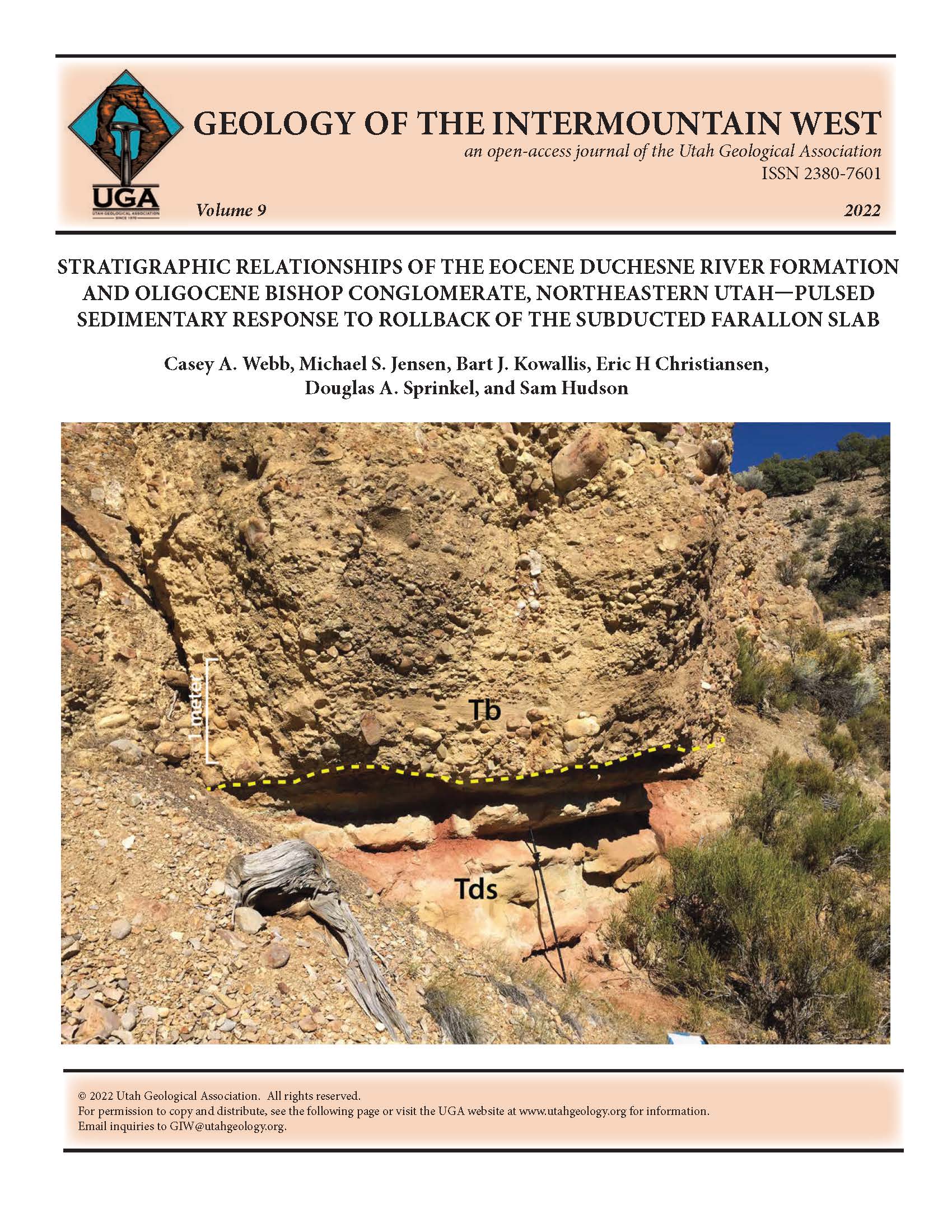Stratigraphic relationships of the Eocene Duchesne River Formation and Oligocene Bishop Conglomerate, northeastern Utah—pulsed sedimentary response to rollback of the subducted Farallon slab
Abstract
The Uinta Mountains are an east-west-trending, reverse fault-bounded, basement-cored Laramide uplift. The Eocene Duchesne River Formation and Oligocene Bishop Conglomerate represent late stage, intermontane basin fill of the Uinta Basin in northeastern Utah. Detailed mapping (1:24,000 scale), clast counts in conglomerate beds, description of lithology and stratigraphic contacts, and radiometric dating of pyroclastic fall beds of the Duchesne River Formation and Bishop Conglomerate in the Vernal NW quadrangle in northeastern Utah reveal stratal geometries of middle Cenozoic depositional units, the uplift and unroofing history of the eastern Uinta Mountains, and give evidence for the pulsed termination of Laramide uplift related to rollback of the Farallon slab and lithospheric delamination. These relationships show the continuation of Laramide uplift in this region until after 37.9 Ma and before 34 Ma, an age younger than the previously reported 45 to 40 Ma. The Duchesne River Formation consists of four members: the Brennan Basin, Dry Gulch Creek, Lapoint, and the Starr Flat. A normal unroofing signal is found within the formation with a downward increase in Paleozoic clasts and an upward increase in Proterozoic clasts. The oldest member, the Brennan Basin Member contains 80% to 90% Paleozoic clasts and less than 20% Proterozoic clasts. Conglomerate beds in the progressively younger Dry Gulch Creek, Lapoint, and Starr Flat Members of the Duchesne River Formation show significant increases in Proterozoic clasts (34% to 73%) and a decrease in Paleozoic clasts (27% to 66%). The Bishop Conglomerate overlies the Duchesne River Formation, but shows no clear change in clast composition. In the Duchesne River Formation, the proportion of beds containing fine gravel to boulder-sized clasts decreases significantly with distance from the Uinta uplift, from almost 100% near the source (<0.5 km) to 50% to 20% to the south (10 km). The lower part of the Duchesne River Formation exhibits a fining upward sequence that may represent a lull in tectonic uplift. The fine-grained lithofacies of the Dry Gulch Creek and Lapoint Members of the Duchesne River Formation pinch out within about 1 to 2 km from the Uinta uplift. In this proximal region conglomerates equivalent in age to the Lapoint Member cannot be separated from the younger conglomerates of the Starr Flat Member and are mapped together as one unit. Where the fine-grained lithologies appear farther from the uplift, the Starr Flat Member conglomerates deposited above Lapoint Member siltstones represent a southward progradation of alluvial fans away from the uplifting mountain front. The Starr Flat Member is overlain by the Bishop Conglomerate. These units are similar in sedimentary structure and clast composition and are distinguished by an angular unconformity that developed after 37.9 Ma. Stratigraphic and structural relationships between the Duchesne River Formation and Bishop Conglomerate reveal evidence of at least three episodes of Laramide-age uplift of the Uinta Mountains during the deposition of these formations: (1) deposition of fining upward sequences beginning with a basal coarse-grained unit within the Brennan Basin, Dry Gulch Creek, and Lapoint Members; (2) progradation of alluvial fans to the south form the younger Starr Flat Member resulted from an increase in sediment supply likely associated with renewed uplift; and (3) tilting and truncation of Duchesne River Formation to form the Gilbert Peak erosional surface, and prograding alluvial fans of the Bishop Conglomerate. These episodes of pulsed uplift are possibly the result of dripping lithosphere that occurred during Farallon slab rollback. New 40Ar/39Ar ages of 39.4 Ma from ash beds in the Dry Gulch Creek and Lapoint Members emplaced from Farallon rollback volcanism help to constrain the timing of deposition and uplift. These new ages and other existing radiometric and faunal ages suggest a significant unconformity of as much as 4 m.y. between the Duchesne River Formation and the overlying Bishop Conglomerate, which rangesfrom 34 to 30 Ma in age and show that Laramide uplift continued after 40 Ma in this region.





